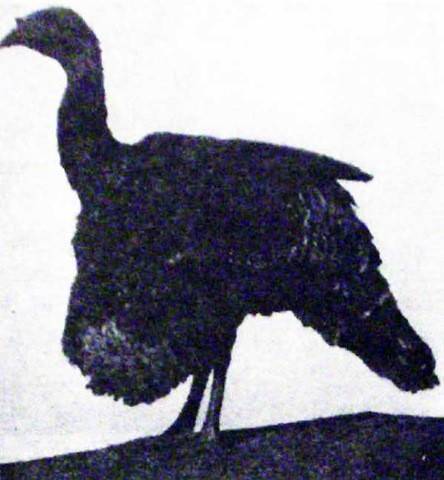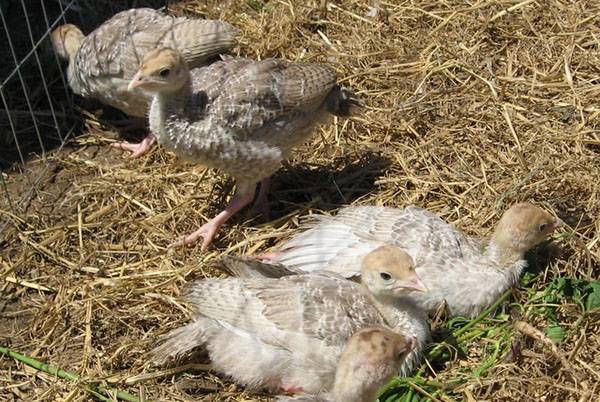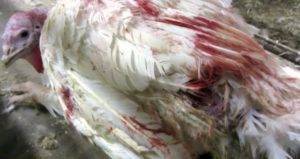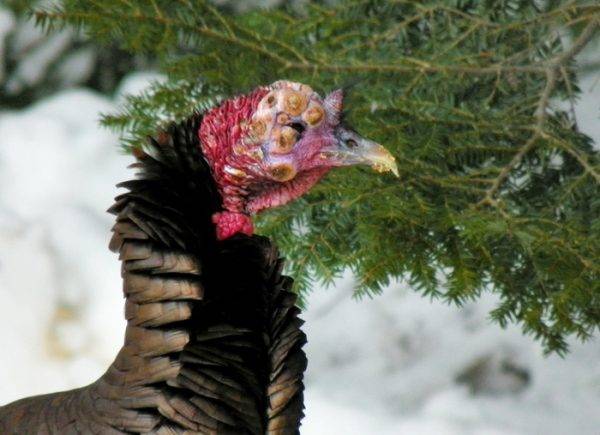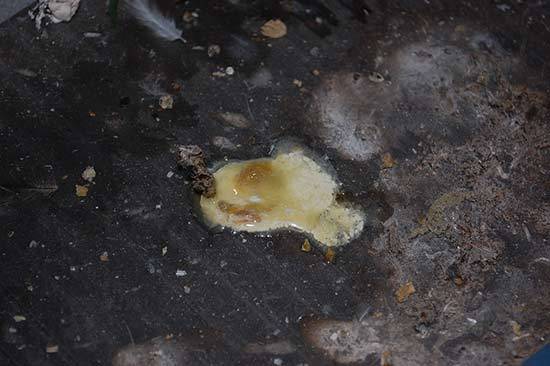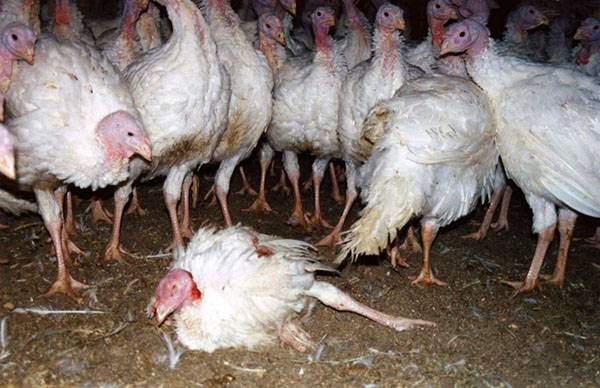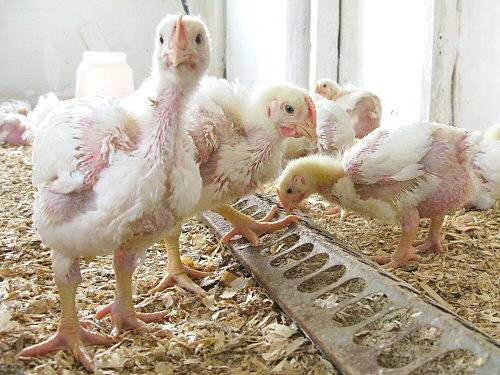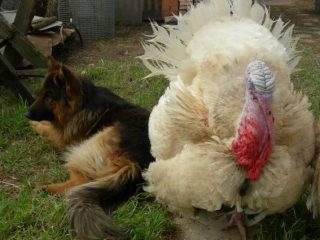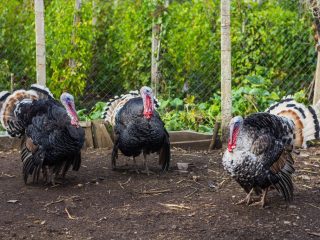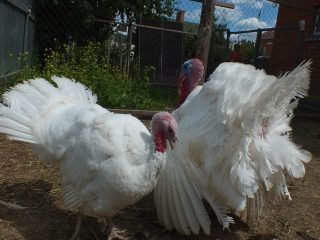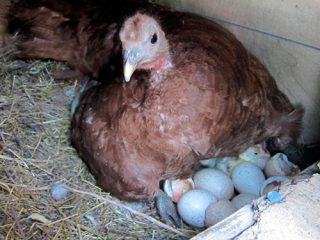Content
- 1 Hard goiter in turkeys
- 2 Swollen goiter
- 3 Rickets in turkeys
- 4 Pecking and cannibalism in turkeys
- 5 Avitaminosis in turkeys
- 6 Measures for the prevention of infectious diseases
- 7 Infectious diseases of turkeys with a description and photo
- 8 Potential Problems That Broiler Poult Owners May Face
When buying turkey poults or adult poultry for breeding for sale, you will have to take into account the tendency of turkeys, especially turkeys, to disease. There is even an opinion that turkey poults get sick and die from the slightest breath of breeze, but adult birds are practically not susceptible to diseases. Because of this opinion, the owners of turkeys often become perplexed, not understanding what the adult turkeys are ill with in their courtyard.
In fact, the picture is somewhat different. Diseases of turkeys are often common with diseases of chickens... For example, Newcastle disease and the flu (avian plague) affect both chickens and turkeys. Therefore, disease prevention measures are often the same. If the owner of the courtyard has a mixed livestock on the farm, then you need to watch twice. Birds can infect each other.
Common infectious diseases often affect not only birds, but also mammals.
Such diseases include: salmonellosis, smallpox, leptospirosis, pasteurellosis, colibacillosis.
A fairly long list of turkey diseases can be seen in the video of a turkey breeding workshop held in 2014.
Non-infectious diseases of turkeys occupy a very insignificant place in the general list, but they are often the main problem of keeping turkeys, since with some care and prevention, the infection can not be brought into the farm, and the feeding of the poultry depends solely on the knowledge and beliefs of the owner.
Many owners feed their turkeys with whole grains, as the most natural and natural food, to which "antibiotics are not added", according to the conviction of many, added by the manufacturer to the compound feed.
A turkey eating whole grains can result in a so-called hard goiter.
Hard goiter in turkeys
This usually happens if the bird has been starving for a long time and, after the hunger strike, ate food too greedily. After feeding, the turkeys go to drink. Whole grain accumulated in the goiter swells from water, swells the goiter and clogs the esophagus. Lack of stones or shells for grinding grain can only affect the stomach. In this case, the root cause of hard goiter is intestinal blockage at the exit from the stomach.
When feeding turkeys with factory compound feed, this does not happen, since when water gets on the compound feed, the latter immediately soaks into a gruel, for the assimilation of which even pebbles are not needed. With a sufficient amount of water drunk by a turkey, the gruel turns out to be liquid.
In theory, the goiter of a turkey can be surgically opened and the swollen grain removed. But this procedure must be carried out by a veterinarian, and therefore it is usually more profitable to slaughter the turkeys than to treat them.
Symptoms of a hard goiter
Apathy. The goiter on palpation is hard, tightly packed. Turkeys refuse to feed. Depletion and decreased egg production in turkeys is observed if the disease develops during the laying season. Due to the pressure of the goiter on the trachea, breathing of turkeys is difficult, subsequently death from suffocation occurs.
Treatment of hard goiter
When clogged, the goiters of the turkeys are opened and their contents are surgically removed. After that, vaseline oil is injected into the goiter of the bird, sunflower oil can be used. After massaging the goiter, the contents of the goiter are removed, in fact, squeezed out through the esophagus.
Swollen goiter
External signs are almost the same as with a hard goiter. The goiter is unnaturally large, but soft to the touch.
It is believed that this can happen if the turkey drinks too much water in the heat. In fact, hardly, except that the whole day to starve him in the sun. If the bird's water is freely available, then the turkeys drink as much as they need and little by little. In addition, water can be absorbed into the tissues through the goiter mucosa.
In fact, it is goiter catarrh or goiter inflammation caused by poor quality feed in the turkey's diet. Goiter disease develops when turkeys are fed rotten feed of animal origin, moldy grain, or if the bird has reached mineral fertilizers. The goiter can also become inflamed when a foreign object is swallowed by a turkey.
Bread can be the cause of a large but soft goiter in a turkey, as the bread can clump into a sticky mass that clogs the intestines and begins fermentation.
Symptoms of a soft goiter
The condition of the turkey is depressed, often the appetite is reduced or absent altogether. The poultry crop is soft, often filled with fermentation products of poor quality feed. When you press on the goiter, you can smell a sour smell coming from the turkey's beak.
Prevention and treatment of soft goiter
In the case of opening the goiter, the bird is given a solution of potassium permanganate instead of water on the first day. Antimicrobial drugs and mucous decoctions are also used.
Rickets in turkeys
Turkeys of heavy crosses are more likely to get sick, since they require a significant amount of calcium and protein for growth. But turkey poults of egg breeds are also susceptible to this disease. Even if there is enough calcium in the diet of turkey poults, it will not be absorbed without vitamin D₃. And with an excess of phosphorus, calcium will begin to wash out of the bones of turkeys, which will lead to osteoporosis. Just adding vitamins to the diet of turkey poults does little, since for the normal assimilation of this vitamin, animals also need movement. If the chicks suddenly become lethargic, walking outdoors for a long time can help. It is only necessary to equip a shelter from the sun, where the turkeys can hide in case of need.
Adult turkeys are relatively inactive, but even they need at least 20 m² per head for normal production of offspring. Turkey poults are even more mobile and die without movement. Which, by the way, explains the belief that turkey poults are very gentle creatures that die from drafts. Owners, raising turkeys at home, keep turkeys in very close quarters.
Pecking and cannibalism in turkeys
The second consequence of too crowded turkey housing and lack of physical activity of the bird is stress. Their visible signs are often self-incriminating, fighting and cannibalism. It is believed that this is due to vitamin deficiencies, lack of animal protein or minerals. In fact, both self-talkativeness and cannibalism, expressed in slaughtering fellows, are an external manifestation of the stress experienced by turkeys.
Avitaminosis does not manifest itself in self-spreading, these are the consequences of stress.
Avitaminosis in turkeys
With hypovitaminosis, the formation of the feather cover is disrupted, the eyes are often watery and the eyelids swell, and appetite perversion can be observed. Pecking of eggs often occurs not with vitamin deficiencies, but with a lack of calcium, protein or fodder sulfur in the diet of birds.
In theory, you can add animal feed to the diet of birds and see what happens. But when breeding heavy crosses of turkeys, it is better to use ready-made feeds intended for them, and not to improvise.
If you adhere to the technique developed by specialists for growing turkeys, then most of the non-infectious diseases caused by an improperly formulated diet can be avoided.
The situation with infectious diseases of turkeys is worse. Many diseases in turkeys caused by viruses or microorganisms cannot be cured. The bird has to be slaughtered. However, some of these diseases can be introduced into the farm in a hatching egg.
It is due to the fact that the eggs themselves are often infected, there is a high mortality rate of chickens, turkeys, pheasants and other hens in the first days after hatching.
What does a sick turkey look like?
Measures for the prevention of infectious diseases
Measures for the prevention of infectious diseases in turkeys are the same as for the prevention of these diseases in other birds: to buy turkey poults and eggs for incubation only from safe farms.
As with chickens, there is usually no cure for infectious diseases in turkeys, so it is easier to prevent the disease than to try to treat it at home.
To prevent the introduction of infection into the farm, in addition to strict quarantine measures and the purchase of material for breeding turkeys only from prosperous sellers, internal sanitary measures must be observed: regular disinfection of premises and equipment, regular change of litter, regular prevention of helminthiasis and coccidiosis.
Infectious diseases of turkeys with a description and photo
One of the rather unpleasant diseases affecting not only birds, but also mammals is smallpox, which has several types, currents and forms.
Smallpox
Smallpox is not caused by a single virus, but by several different species and genera belonging to the same family. There are three independent varieties: cowpox, sheep pox and bird pox.
The group of viruses that cause smallpox in birds includes three types of pathogen that affect different families of birds: chickenpox, pigeon pox and canary pox.
Owners of turkeys are only interested in smallpox of chickens, which also affects other members of the pheasant family.
Chicken pox symptoms
The incubation period for smallpox in birds can last from a week to 20 days. The disease manifests itself in birds in 4 forms: diphtheroid, cutaneous, catarrhal and mixed.
Diphtheroid form of the disease. Rash on the mucous membranes of the respiratory system in the form of films, wheezing, open beak.
Cutaneous form of the disease. Pockmarks on the head.
Catarrhal form of the disease. Conjunctivitis, sinusitis, rhinitis.
Mixed form of the disease. Pockmarks on the scalp and diphtheroid films on the oral mucosa.
Lethal outcomes in case of avian pox disease reach 60%.
When diagnosing poultry pox, it is necessary to distinguish it from avitaminosis A, candidamidosis, aspergillosis, turkey sinusitis, respiratory mycoplasmosis, the symptoms of which are very similar.
Unlike many specific bird diseases, smallpox can be cured.
How to treat bird pox
In birds, symptomatic treatment is carried out, cleaning and disinfecting pockmarks from a secondary infection. The diet of birds is enriched with vitamin A or carotene. Give an increased dose of vitamins. Antibiotics are added to bird feed. For the prevention of turkeys, they are vaccinated with a dry embryo-virus vaccine.
Respiratory mycoplasmosis
Also called turkey sinusitis and air sac disease.A chronic illness characterized by respiratory damage, decreased productivity, sinusitis, numbness, and wasting.
RM symptoms
In turkeys, the incubation period of the disease lasts from a couple of days to two weeks. Turkey poults get sick at the age of 3 - 6 weeks, an adult bird during oviposition. In the yolk of the egg, the virus persists throughout the incubation period, therefore, there is an increased mortality of embryos and turkey poults in the first day after hatching.
In respiratory mycoplasmosis, three courses of the disease are distinguished: acute, chronic and mixed.
The acute course of the disease is more often observed in turkey poults. Symptoms of the acute course of the disease: the first stage - loss of appetite, sinusitis, tracheitis; the second stage - cough, shortness of breath, catarrhal rhinitis passes into the serous-fibrous stage, in some turkeys conjunctivitis develops, growth stops, in adult birds there is depletion and a decrease in egg production. In the acute course of the disease, the percentage of deaths in turkeys reaches 25%.
In the chronic course of the disease, the symptoms are rhinitis and wasting. In birds, fluid accumulates in the throat, which adult turkeys try to get rid of.
In turkeys, the eyeball protrudes and atrophies, the joints and tendon sheaths become inflamed, and wheezing appears. In the chronic course, up to 8% of adult birds and up to 25% of turkeys die.
Treatment and prevention of the disease
There is no cure developed for respiratory mycoplasmosis. Antibiotics of a wide spectrum of action are used according to the schemes indicated in the instructions. Antibiotics are not used for obviously sick turkeys, but for the entire group of birds at once.
For sick poultry, antibiotics are not used, since in case of an outbreak of disease, sick turkeys are destroyed. Conditionally healthy poultry are fed with antibiotics and left to obtain meat and edible eggs.
The premises and equipment are disinfected, bird droppings are calcined at a high temperature. The quarantine is removed from the farm only after all the conditionally healthy poultry has been slaughtered, and among the brood herd of turkeys and turkeys grown up to 8 months, there was not a single case of the disease.
Pullorosis
He is "white diarrhea". It is believed to be a disease of young animals. In fact, there are two variants of the disease: "child" and "adult". Their signs differ beyond recognition of the disease, so people often believe that white diarrhea in turkeys and problems with the reproductive system of turkeys are different diseases and there is nothing in common between them.
In turkey poults, pullorosis causes septicemia, in common parlance "blood poisoning", damage to the gastrointestinal tract and the respiratory system. In an adult bird - inflammation of the ovaries, oviduct and yolk peritonitis.
Symptoms of the "child" version of pullorosis
Poultry poultry is divided into two types: congenital and postnatal. With congenital poults, they hatch from already infected eggs, with postnatal they become infected when sick and healthy poults are reared together.
Congenital pullorosis. The incubation period is usually 3 to 5 days. Sometimes it can go up to 10. Main symptoms:
- refusal of feed;
- weakness;
- lowered wings;
- ruffled feather;
- poor plumage;
- the yolk is not drawn into the abdominal cavity (in these cases, turkey poults usually do not live longer than 1 day);
- white, liquid droppings (white diarrhea);
- Due to liquid droppings, the fluff around the cloaca is glued together with excrement.
In postnatal pullorosis, three courses of the disease are distinguished: acute, subacute and chronic. The incubation period for this form is 2-5 days after hatching of turkey poults from eggs.
Symptoms of postnatal pullorosis in turkey poults in the acute course of the disease:
- indigestion;
- weakness;
- breathing through an open beak, not the nasal openings;
- white mucus instead of droppings;
- obstruction of the cloacal opening with fluff glued together;
- poults stand with their paws apart and eyes closed.
The subacute and chronic course of the disease occurs in turkeys 15-20 days of age:
- poor feathering;
- developmental delay;
- diarrhea;
- in broilers, inflammation of the joints of the legs.
The mortality rate in subacute and chronic pullorosis in turkeys is low.
Symptoms of "adult" pullorosis
In adult turkeys, pullorosis is asymptomatic. Periodically, there is a decrease in egg production, yolk peritonitis, inflammation of the ovaries and oviduct, intestinal disorders.
Treatment of the disease
Obviously sick turkeys are destroyed. Conditionally healthy birds are treated with antibacterial drugs, using them according to the scheme prescribed by the veterinarian or indicated in the annotation to the drug.
Prevention of pullorosis
Compliance with veterinary requirements for incubating eggs and keeping and feeding turkeys. A ban on the export and sale of products from farms infected with pullorosis.
Potential Problems That Broiler Poult Owners May Face
Diseases of turkey poults of heavy broiler crosses often consist in common rickets, when the bones do not keep up with the rapidly growing muscle mass. If the owner wants to grow such turkeys up to 6 months, having received a turkey weighing about 10 kg, he will have to use industrial technologies for growing broiler turkeys using furazolidone, coccidiostatics and compound feed for broiler turkeys with a growth stimulator.
Frightening to many, the phrase "growth stimulant" is actually a correctly selected formula of vitamins and minerals that a turkey needs for proper development, and not mythical steroids.
If the owner chooses to raise such crosses of broiler turkeys on his own feed, he will have to slaughter them in 2 months, since after this period a large percentage of turkeys will start to "fall on their feet" due to an incorrectly balanced diet.
To avoid diseases of turkey poults of broiler crosses, you will have to use developments for industrial poultry farms.
How to drink turkey poults of heavy crosses can be seen in this video.
There are no specific infectious diseases in turkey poults. Turkeys of all ages suffer from infectious diseases. But poults are more susceptible to infections and require special attention.

